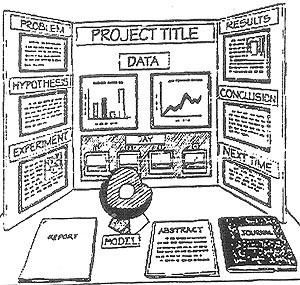|
All Projects Undergo Display and Safety Check
Setup is at Seminole Towne Center Mall from 7:00 - 9:00 am. Enter at Food Court entrance on upper level on side facing I4.
- Check is at Registration Desk at Food Court entrance to obtain your Official Entry Card and a Mall map showing location of your category.
- Setup your project in the numbered space provided.
- Remember to bring supplies like tape, scissors, etc. and anything you need for setup.
- After you have set up your project, a Display and Safety Judge must check your project and sign your Entrant Card.
- You must be present when the D&S Judge checks your project.
- The D&S Judge will check for:
- Display is within the size measurements
(6' tall x 4' wide x 30" deep for table)
(9' tall x 4' wide x 30" deep for floor)
- Abstract in lower left corner, uses State Science Fair form, and is in correct format with no more than 250 words
- NO Organisms, living or dead, including plants, animals, and microorganisms are to be displayed!
- NO photographs of vertebrate animals/humans in other than normal conditions! These photographs may be in a notebook presented only during D&S certification and judging. All pictures of human subjects MUST be accompanied by a consent form which grants permission to use the pictures.
- NO food
- NO soil or waste samples. Rocks and minerals that have no hazardous chemicals maybe displayed in a covered and secured case.
-NO chemicals, including water. No liquids unless they are a critical part of an operative apparatus. These must be removed after judging.
-NO human or animal parts, histological section, or wet mounts.
-NO sharp or sharp edged items
-NO poisons, drugs, controlled substances, hazardous substances or devices.
-NO gases under pressure or super-cooled gases, including dry ice.
-NO unshielded belts, pulleys, chains, or moving parts that pose a hazard.
-NO lasers or scientific instruments which do not meet ISEF standards. NO Class III or IV lasers may be operated. Lasers MUST have an undamaged, unaltered, readable, original label class.
-NO unshielded high-voltage equipment, vacuum tubes or ray-generating devices; No batteries with open-top cells; NO bare wires or exposed knife switches. NO car or motorcycle batteries.
-NO non-functional apparatus or chemical containers.
-NO loud, disturbing sounds produced by equipment; NO bright lights.
-NO small objects that are not encased or attached to project.
-NO awards, medals, business cards, flags, acknowledgements. Copy of abstract is okay to hand to judges (no personal information).
-NO glass except computer monitors, television screens, shielded fluorescent lights. NO unsecured glass and NO picture frames (acrylic is okay).
NO STUDENT MAY COMPETE WITHOUT A SIGNED DISPLAY AND SAFETY CARD!
Once you have completed the D&S check, you may leave your project.
Remember, judging starts promptly at 9:30 am and you must be with your project for judging!
|
|

Placement of Materials on Display
The only mandatory placement is abstract.
It must be correct SSEF format.
It must be placed in lower left corner for table projects or left side at table heighth for floor projects.
You should use headings for scientific method steps: Problem, Hypotheses, Materials and Methods, Findings/Data/Results, and Conclusions
Headings may be on separate mat or paper, or at top of printed section.
You may also want to include additional headings: Future Research Plans; Bibliography
|
Maximum Dimensions for Display Board
Table Project:
6' tall, 4' wide,
30" deep
Floor Project:
9' tall, 4' wide,
30" deep
This includes hinges, title, etc.
|
|


